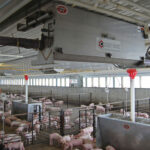A Farm With A View
The 40-acre Windmist Farm’s location—on the busy corridor between Boston and the suburbs of southern Connecticut—makes it ideal for many of the Northeast’s discerning foodies. The cars on North Road will often slow down just a bit to take in...
A Farm With A View
The 40-acre Windmist Farm’s location—on the busy corridor between Boston and the suburbs of southern Connecticut—makes it ideal for many of the Northeast’s discerning foodies. The cars on North Road will often slow down just a bit to take in...The 40-acre Windmist Farm’s location—on the busy corridor between Boston and the suburbs of southern Connecticut—makes it ideal for many of the Northeast’s discerning foodies. The cars on North Road will often slow down just a bit to take in the view.
But it’s the food the farm produces that is worth stopping for.
George and Martha Neale’s herd of “Belties,” more than five dozen head of Belted Galloway, is eye-catching to the tourists, but it’s a genuine draw for Windmist customers. A coarse, shaggy outer coat makes it well-suited for the chilly New England climate, without the layer of back fat that usually keeps cattle naturally warm. The result is not only lean meat for the customer, but efficiency for the producer; carcass weights are often 60% or more of live weights. At Windmist, Belties are exclusively grass-fed, offering yet another healthy advantage for the foodie customer.
Windmist’s location also allows the Neales to take advantage of an innovative, local process scheduling system. Martha says their beef-processing cycle is the envy of neighboring states, and could serve as a model for others who retail their own beef.
Over time, much of the infrastructure for beef processing has shifted to the Midwestern U.S., leaving fewer and fewer USDA-inspected processing facilities behind for the smaller producer. Rhode Island’s answer to such a shortage is the Rhode Island Raised Livestock Association (RIRLA). Founded in 2005 and supported by grants from USDA and other fundraising efforts, RIRLA partners with meat-processing facilities for a soup-to-nuts option for farm retailers: Deliver an animal, receive meat products from said animal already Cryovac®-sealed and frozen. “In other words, ready to sell!” says Martha.
Farmers’ markets and direct sales to chefs and grocers through web sites, such as Farm Fresh Rhode Island (www.farmfreshri.org), help the Neales clear inventory and sell niche products. “On the weekends I list what I have available, chefs and grocers place their order on Monday, on Tuesday I get my list of what sold, I pack for delivery on Wednesday, and the restaurant has it on Thursday.” Plus, she says, “it’s great to see our farm’s name on a menu.”
All of this, and the farm continues to expand. Their home garden, for instance, has turned into a year-round functioning greenhouse, thanks to USDA’s seasonal high tunnel program. The Neales’ 1,200-square-foot greenhouse extends their growing season by weeks on either side for vegetables, while providing shelter for greens in the winter.
Meanwhile, other farms in the area help create something of a “slow-food district” on the island. The Neales credit their neighbors with raising grass-fed beef years before they did, and a farmstand across North Road sells fresh vegetables; all the more reason for weekenders to slide down that Newport Bridge ramp and pick up a little something for the week ahead.
Read the full story and learn why a great experience with a Massey Ferguson tractor—and a great deal—helped the Neales decide they “won’t be going back to John Deere.” http://www.myfarmlife.com/features/a-farm-with-a-view/
Tell us what the “slow-food” movement means to you. Is your farm serving the local food movement?






